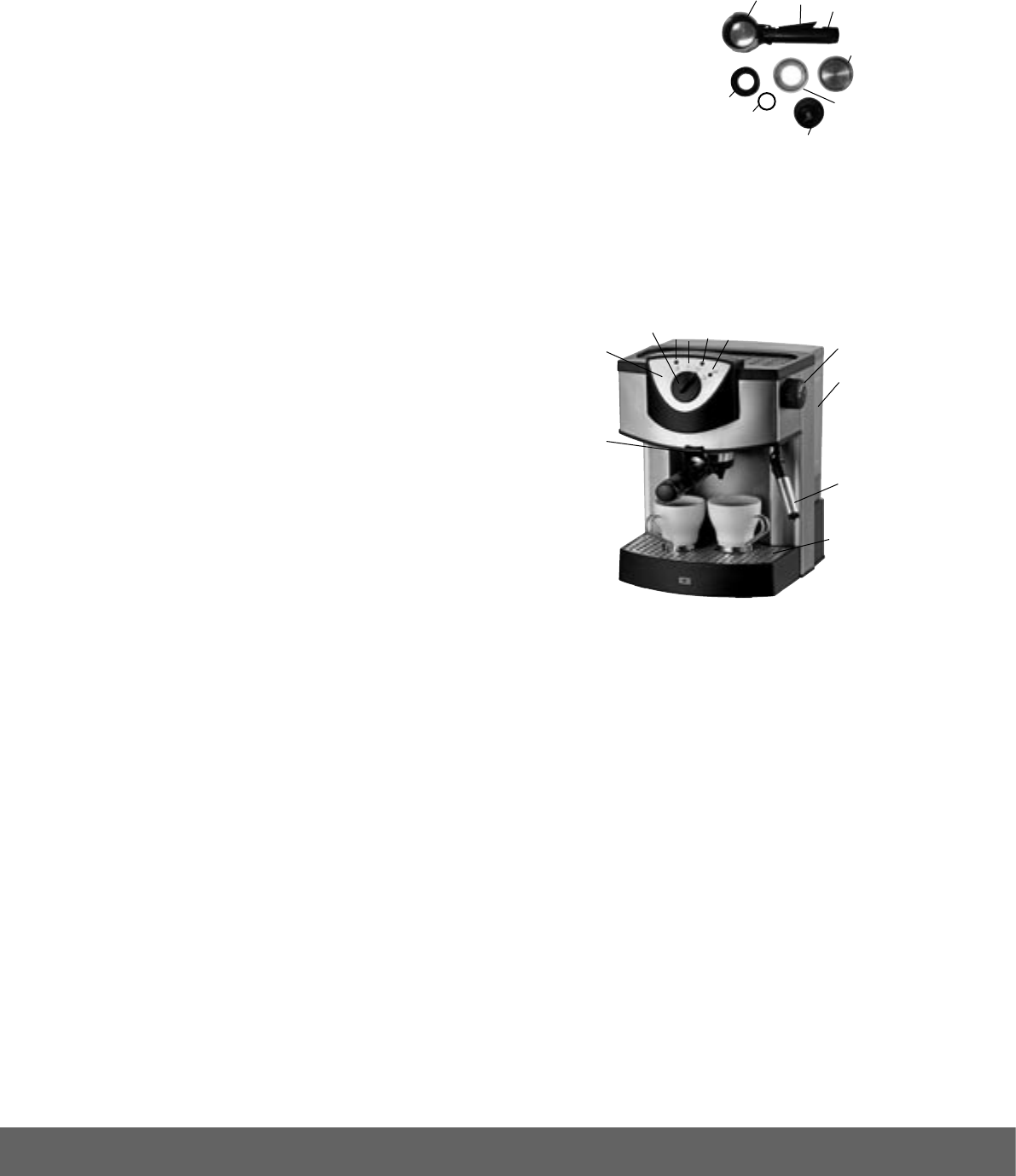
14
14
INTRODUCTION
To get the best out of your new espresso maker, please read
through these instructions carefully before using it for the first
time. We also recommend that you keep the instructions for
future reference, so that you can remind yourself of the functions
of your espresso maker.
SAFETY MEASURES
Normal use of the espresso maker
• Incorrect use of the espresso maker may cause personal
injury and damage to the appliance.
• Use the espresso maker for its intended purpose only. The
manufacturer is not responsible for any damage resulting
from incorrect use or handling (see also the ‘Guarantee
Terms’ section).
• Use only accompanying accessories or those recommended
by the manufacturer.
• The espresso maker may only be connected to 230 V, 50 Hz.
• The espresso maker or cord must not be immersed in water
or any other liquid.
• Do not touch the espresso maker with wet hands.
• Never leave the espresso maker unattended when in use and
keep an eye on children.
• Never put hot or boiling water in the reservoir. Use cold water
only. Ensure the appliance is switched off when filling with
water.
• The water level in the reservoir must be between the MAX
and MIN marks on the water level indicator on the side of the
reservoir.
• Never use the brewing function or the frothing function for
more than one minute at a time, and do not use them at the
same time.
• The metal parts get very hot during use. Touch the plastic
parts and handles only.
• The espresso maker should never be switched on unless it
contains water or descaler.
• Freshly-brewed coffee and cappuccino steam are extremely
hot. Take care to avoid scalding yourself or others.
• This espresso maker is not suitable for commercial or outdoor
use.
Where to put the espresso maker
• Always place the espresso maker at a safe distance from heat
sources such as ovens, cooking rings or similar.
• Always place the espresso maker at the back of the kitchen
counter.
• Do not cover the espresso maker.
• The espresso maker must not be placed anywhere with an
ambient temperature around or below freezing point (0°
C). If the water in the reservoir freezes it may damage the
appliance.
• Do not allow the cord to hang over the edge of a table/
counter, and keep it away from hot objects and naked flames.
Cord, plug and mains socket
• Check regularly that neither the cord nor plug is damaged
and do not use the espresso maker if it is, or if it has been
dropped or damaged in any other way.
• If the espresso maker, cord or plug is damaged, the appliance
must be inspected and, if necessary, repaired by an
authorised repair engineer, otherwise there is a risk of electric
shock. Never attempt to repair it yourself.
• Remove the plug from the socket before fitting or removing
the filter, before cleaning, or when the espresso maker is not
to be used for a while.
• Avoid pulling the cord when removing the plug from the
socket. Instead, hold the plug.
• The cord must not be twisted or wound around the appliance.
• Keep the cord away from heat sources and the hot parts of
the espresso maker.
• Check that it is not possible to pull or trip over the espresso
maker cord or any extension cord.
KEY
1. Control panel
2. Steam regulator
3. Water reservoir
4. Steam nozzle
5. Drip tray
6. Filter holder
7. Release lever
8. Handle
9. Filter, 1 cup
10. Plastic insert
11. Sealing ring
12. Filter, 2 cups
13. Tamper
14. On/Off knob
a. Frothing position
b. Off position
c. Heating position
d. Brewing position
15. Brewing head (underneath the upper section of the espresso
maker)
PRIOR TO FIRST USE
Each individual espresso maker is checked at the factory, but for
safety’s sake, after unpacking the appliance, you should check
carefully that it has not been damaged during transport.
Place the espresso maker on a flat, stable surface, such as a
kitchen counter.
Flushing through
The espresso maker should be flushed through before it is used
for the first time.
• Pour water into the reservoir (3) up to the MAX mark.
o The reservoir can be filled while it is on the espresso maker,
or alternatively it can be taken off and filled directly under
the tap and then put back into place. Remember to put the
lid on when the reservoir has been filled. When replacing the
reservoir, ensure that the valve in the bottom of the reservoir
fits into the connector on the espresso maker itself.
• Check that the steam regulator (2) is completely closed by
turning it clockwise, as otherwise water will come out of the
steam nozzle (4) when you flush it through.
• Place a container (e.g. a large cup) beneath the brewing head
(15), to catch any water dripping down.
• Turn the on/off knob (14) on the control panel (1) to brewing
position (d). The red LED over the heating position (c) goes
on.
UK
1.
2.
3.
4.
5.
6.
7.
8.
9.
11.
10.
12.
13.
14.
a.
b.
c.
d.
15.


















